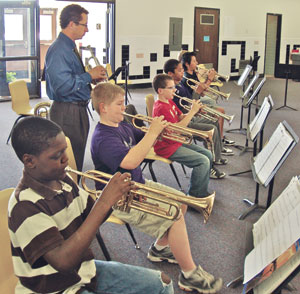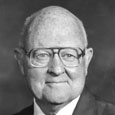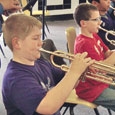 Horn virtuoso Philip Farkas once wrote about three factors that had the greatest influence on students’ achievement: repetition, intelligent analysis, and correct instruction. Of these, he suggested that the most important is repetition (The Art of Horn Playing).
Horn virtuoso Philip Farkas once wrote about three factors that had the greatest influence on students’ achievement: repetition, intelligent analysis, and correct instruction. Of these, he suggested that the most important is repetition (The Art of Horn Playing).
Whether you agree with Farkas or have differing ideas, anyone who has taught beginning instrument classes will appreciate the enormous amount of repetition that takes place to play an instrument. In fact, the repetition is so great it can lead to a high level of monotony. While having an enormous amount of self-discipline helps in mastering an instrument, it is usually a quality in short supply with adolescents.
Short-term motivation is the obvious answer, and the all-time, unsurpassed king of incentives for teaching beginners is a daily audition called the six-second tryout. Here is how to set it up:
•Select a short excerpt from the lesson that students can perform in six seconds or less as an audition.
•Ask them to play it several times so they know and understand the tryout material.
•Establish a routine in which students audition by playing the excerpt one after the other, adding two beats of silence between each student.
•Require students to play the tryout rhythmically, perhaps with the help of a metronome.
A Twinkling Example
For a six-second audition, the teacher selects two measures of a tune, such as “Twinkle, Twinkle, Little Star,” and asks the class to play it at about MM=72. Next the students rest for two beats then repeat the tune. Rehearsing the excerpt with the two-count rest and repeating it several times will communicate the idea. Students need to grasp a sense of resting two counts and then immediately playing the excerpt.
Next instruct the students to begin, first with one player (use “one, two, ready play” or some variation to start), then each student successively plays the audition after the two-count rest. If a student fails to start on time, reduce his score, explaining that if there is a breakdown in counting, you’ll have to start the next auditioner.
Timing Is Everything
The two seconds of silence gives teachers an opportunity to evaluate the playing and assign it a score, which becomes a guide for assigning chairs for the next class. If students perform the six-second excerpt and the two count rest in approximately eight seconds, a little math shows you can hear about eight students per minute; a class of 12 can play the audition in one minute, 36 seconds, and a class of 24 students can play the audition in a little over three minutes.
The evaluation has to take place quickly and succinctly or students become bored. One suggestion is giving a student who plays perfectly a score of zero; one mistake gets a score of 1; two mistakes receives a score of 2, etc. You can also evaluate students using a scale of 1 to 10 with 10 being the best possible score, or adapt contest ratings with a First Division best score indicated as I+, I, I-, II+.
Don’t Bog Down
The six-second tryout used daily will motivate students, only if the teacher is efficient. Students grow restless if the process bogs down and takes 5 or 10 minutes. The secret is to quickly assign a rating to the audition within the allotted two beats of rest and keep the tryout moving along.
This is not the time to work individually with students or to explain the rating system to them. Another way to keep the pace moving quickly is assigning chairs following these ideas:
•Keep the competition on a small scale, with between 4 to 15 students.
•For groups larger than 15, ask everyone to replay the excerpt together after every 8-10 students audition, just to keep the playing fresh.
•After hearing each group, ask those who received a “I+” to hold up their hands and assign them chairs. The highest is first, the next highest second, and so on.
•Do the same for “I” students, the second highest chair ranking and finally for students who received a “II+.”
•You can also write ratings on the board or on a grade sheet.
The Daily Six is an excellent way to assess progress every day and develop a written record tracking each student’s playing. Once you complete the audition, then assign chairs. Let students know they have to remember their chairs for the next class. We suggest assigning a penalty for those who can’t remember, such as playing in last chair.
You can use these ratings to highlight problem areas that need improvement and encourage students to do better. For example, if good posture is questionable, add a penalty for poor posture for a week and posture will improve quickly. The same idea works for instrument position, embouchure, foot tapping, bringing the required materials to class, and for any of the details necessary for good instrument performance.
The Satisfaction of Doing Well
The six-second tryout should be a friendly experience, giving each student the chance of sitting in every chair throughout the year and feeling the satisfaction of doing well. Students who receive last chair after every audition soon become discouraged and drop the class. This can be avoided if teachers find creative ways to help everyone succeed as well as change the audition material frequently.
While you should base most tryouts on performance music, there is merit to holding auditions on counting, naming notes, listening for who has the best slur or can hold a note the longest, or a variety of other areas important to instrumental performance.
A good example is the elementary band program at McKinley Elementary School, which had 15 students, including Suzy Jones who played flute. A gifted student who was highly intelligent, Suzy had studied piano since the age of five, and day after day, week after week, continued to win first chair. This was particularly frustrating to Adam Brown, a student who struggled to play clarinet and read rhythms correctly. He was often assigned last chair.
When the tryout focused on who could hold a note the longest, Adam soaked his clarinet reed, took a big breath, and played a soft clarinet note that lasted forever, placing him in first chair. Suzy, like most beginning flutists, couldn’t compete, but it was encouraging to Adam. The result was motivating to both students and kept them practicing.
Using a stopwatch, ask students to name the notes of a passage as fast as they can, but not necessarily in rhythm; be sure to time the result. Here are the notes students will name for the tune “Mary Had a Little Lamb” when played in the key of C:
EDCDEEEDDDEGG
EDCDEEEDDEDC
The first student obviously has the greatest challenge, whereas the one who is 15th gets to mentally practice the note names in advance. This gives an advantage to those seated lower in the sections who never have a chance to move up. If students in high chairs complain, a good answer is that “we’ll have another tryout tomorrow.”
A good teacher will promote the six-second tryout as a game. Be creative, start easily, and give lots of scores that end in a tie. You want to give every child the chance for a first chair. Add little penalties or rewards for posture, position, foot pat, embouchure, articulation, tone, or whatever needs attention.
Occasionally, offer a “plus” for something done extremely well, and above all, conduct the audition quickly and efficiently to keep the class motivated.
If done well, the two or three minutes required for a six-second tryout will become the most interesting, exciting, and highly anticipated part of the class.

Russ Teweleit is the associate director of bands at West Texas A&M University in Canyon, Texas where his duties include conducting the concert band and directing the Buffalo Marching Band. He also teaches graduate courses and is coordinator of music education for the university. He received bachelors and masters degrees from West Texas A&M University and a doctorate degree from the University of Oklahoma.

A 46-year veteran of music education, Harry Haines is professor emeritus of West Texas A&M University in Canyon, where he was chairman of the music department and coordinator of music education for 22 years. In 2002 he was selected for the Texas Bandmasters Association’s Lifetime Music Administrator Award. He received music education degrees from Oklahoma City University and the University of Oklahoma.





